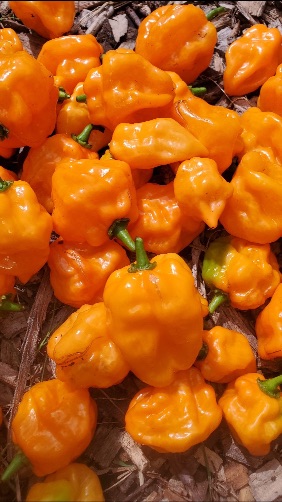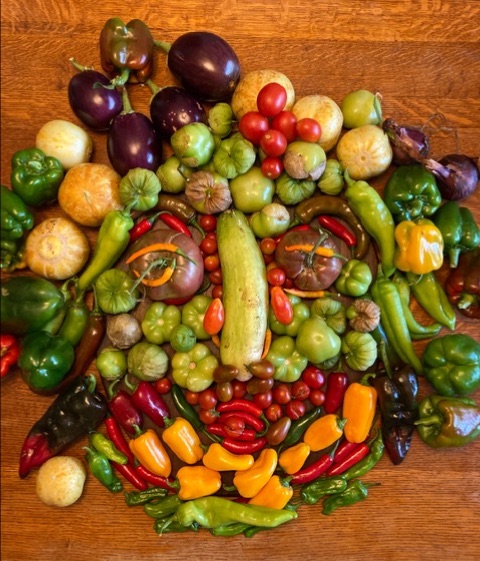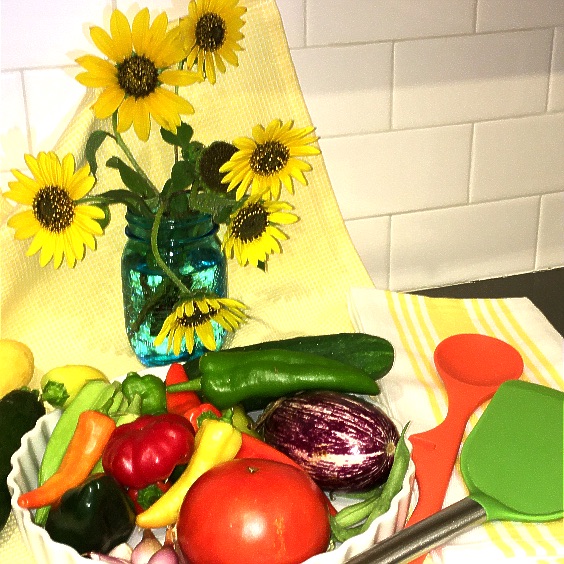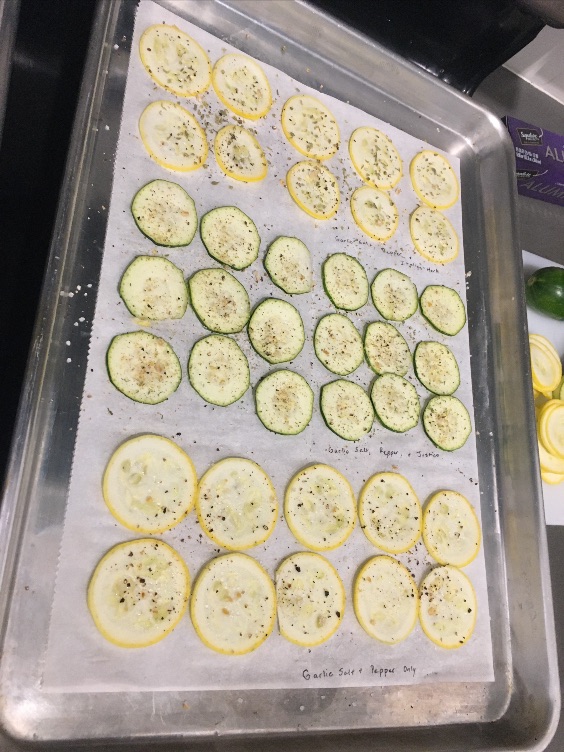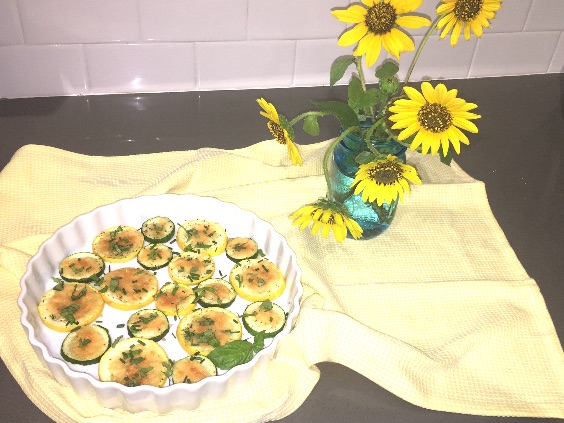
15 July, 2021
www.sunshinecommunitygardens.org
If you are signed up to receive the Weekly Weeder and have not been receiving it, here is a troubleshooting page to help. If this doesn't help, please let Sharon at scgardenweb@gmail.com know. Thanks.
In this Issue:
- Photos: Habaneros by Ruth Roa & Harvest Face by Kerry Drake
- Sunshine's Test Kitchen: Baked Parmesan Squash Rounds
- Social Media Content Creators Wanted
- Herbs That Grow Well in Texas
Baked Parmesan Squash Rounds
Text and Photos by Maria Beach
Welcome to the first installment of Sunshine's Test Kitchen! This will be a recurring feature for the Weekly Weeder and Sunshine Community Garden's Facebook page. Once a month or so recipes for seasonal produce will be tested and tweaked so they can be shared. My hope is that other gardeners will also share their kitchen experimentations.
This edition of Sunshine's Test Kitchen tests two similar recipes for roasting parmesan-topped summer squash. The two original recipes were from the Five Heart Home and Salad in a Jar websites. Both are simple recipes that called for seasoning yellow squash baking, topping with Parmesan cheese, and baking in a hot oven. Best of all, both versions were highly rated by the sites' readers. The version I like best is closer to the Five Heart Home recipe.
My method was to vary several factors: the thickness of the squash slices, the oven temperatures, lining pans with foil slicked with olive oil or parchment paper, and experimenting with different seasonings. The original recipes used only salt and pepper or garlic salt and pepper, but I wanted to see if other flavors added anything to the dish. I tested two types of freshly grated Parmesan, too. I also used a mixture of yellow squash and zucchini.
I first tried squash that was thinly shaved on a mandoline. It was yummy, but cutting the rounds 1/4 inch thick seemed to be a better squash-to-cheese ratio. Both parchment paper and foil greased with olive oil worked well, but the baked squash rounds stuck a bit to the foil (and the olive oil added calories). 425 degrees was best with my oven. I liked all of the flavor combinations I tried, but using garlic salt and Parmesan made the squash rounds a little too salty in my opinion, so I recommend using granulated garlic, black pepper, and (optionally) a favorite salt free herbal blend. If you like, you may also garnish with a chiffonade of fresh herbs at the end. I could not really tell the difference between a store's brand of freshly grated Parmesan cheese and a more expensive type imported from Italy, so the inexpensive type is fine. My spouse is usually not a fan of summer squash, but he ate these happily and I devoured them.
Baked Parmesan Summer Squash Rounds
Adapted by Maria Beach from a recipe by Samantha Skaggs
(View original on Five Heart Home)
Ingredients:
- 2 medium yellow summer squash and/or zucchini
- Granulated Garlic or Granulated Garlic
- Freshly ground black pepper
- Approximately 1/2 cup freshly grated Parmesan cheese* (see note)
Optional Ingredients:
Dried Italian Herbs, Penzey's "Justice," Herbes de Provence, or another favorite salt-free herbal blend. Fresh herbs like basil, chives, thyme, or cilantro
Instructions:
Place an oven rack in the center position of the oven. Preheat the oven to 425°F. Line a baking sheet with parchment paper.
Cut each squash into 1/4-inch thick slices and place the slices in a single layer on the prepared pan.
Sprinkle the squash with granulated garlic or garlic salt and freshly ground black pepper. If desired, also sprinkle your favorite salt-free herb blend on the squash. Place a thin layer of Parmesan cheese on each slice of squash.
Bake until the Parmesan melts and turns a light golden brown. (Start checking after 10 minutes; it may take 15 minutes or more.)
Transfer the squash to a serving dish and shower the finished dish with finely chopped fresh herbs if desired. ?Serve immediately.
*Do not use the shelf-stable kind of Parmesan that comes in a shaker container with a green lid - it will not melt. The refrigerated or deli section type of grocery store grated Parmesan is fine, or you may finely grate your own wedge of cheese.
Sunshine Social Media Content Creators Wanted
Sunshine Community Gardens is looking for skilled creators to provide content for social media. We are seeking photos, copy meant for social media, and short videos. We also need help with cross posting on social media platforms (Instagram and Facebook). You will be working with SCG Head of Social Media, Isabelle Encela. This work counts towards SCG service hours. If you are interested please contact Marsha Riti by email: marsha@marshariti.com
The Herbs Below Grow Well in Texas
-- from Texas A&M AgriLife Extension Fall Planting Guide
Basil
This is one of the easiest herbs to grow, even from seed. However, basil is tender, so expect to lose it at the first sign of frost. Many varieties and flavors of basil are available. The most common is sweet green basil. More unusual varieties are cinnamon, Cuban, globe, holy, lemon, licorice, purple ruffled, Japanese sawtooth, and Thai. Not all are used in cooking.
Basil is the herb to use in all tomato dishes. It can be chopped fine and mixed with butter. Add fresh chopped leaves to vinegar, crushed garlic, and olive oil to make an excellent dressing for sliced tomatoes. It is also used in eggplant, pork, roast chicken, scrambled eggs, and squash dishes.
Catnip
Many cats like to roll all over catnip and any surrounding plants, so it may be best to grow this herb in a hanging basket. Although it is sometimes used to make a hot tea, catnip is of interest mainly to cats.
Chamomile
Chamomile makes wonderful herbal tea. There are two varieties: English and German chamomile. The dried blossoms of either can be used to make tea. The tea can also be used as a hair rinse. To make tea, pour boiling water over about 1 tablespoon of chamomile leaves for each cup desired and let it steep for about 10 to 15 minutes. Filter it through a tea strainer, and add lemon and honey to mask the bitter taste. Chamomile is an easy plant to grow from seed. Roman chamomile is a low-growing ground cover.
Chives
The smallest member of the onion family, chives are easily grown from seeds or transplants. Use this herb any way you would use onions. It can be use it as garnish or added to baked potatoes, cottage cheese, omelets, and sauces.
Comfrey
Is a vigorous herb with large, "donkeyear" leaves that look like green sandpaper. A tea can be made from the leaves or roots.
Coriander
Is also known as cilantro or Chinese parsley. It is easily grown from seed and can sometimes be found growing wild. To have a steady supply of young leaves, sow seeds every few weeks.
Coriander is used in Mexican dishes. The leaves have a strong, "clean" flavor. Use only young leaves; the older ones are too strong.
The seeds have a flavor similar to orange and are used in pastries, sausage, and cooked fruit. They are also an important ingredient in pickling spice and curry powder.
Dill
Is one of the easiest herbs to grow from seed. It will easily become a weed if the seed heads are allowed to dry on the plant. The large green caterpillars that eat dill will turn into swallowtail butterflies, so plant enough for you and them.
Lemon Balm
Lemon balm is a member of the mint family and can be very vigorous. It's best to grow lemon balm in a confined bed area or in containers. It can be started from seeds, cuttings or roots. Once established, it will spread and self-sow, so give it plenty of room. The leaves have a strong lemon odor; they can be used to make tea or flavor regular teas. Lemon balm is also added to fish dishes.
Marjoram and Oregano
They're similar, but the flavor of marjoram is sweeter and more delicate. They're both easy to grow and can be used year round.
Varieties of marjoram include creeping golden marjoram, pot marjoram, sweet marjoram, and winter marjoram. They are best grown from transplants or root cuttings.
The most common types of oregano in Texas are Origanum vulgare, the low-spreading plant used in Italian or Greek foods, and Lippia graveolens or Lippia palmeri, the bushy shrub known as Mexican oregano.
Marjoram and oregano can be used in the same foods & meats, pizza, soups, stews, stuffing, and spaghetti sauce. The leaves are best used dried.
Mints
There are many mints. The easiest to grow is spearmint; peppermint is more difficult. Most mints are tough, hardy plants. Other mints include apple mint, pineapple mint, and orange mint, which is so vigorous that it soon becomes a weed.
All mints appreciate moisture and do best where they get afternoon shade. A good place to plant spearmint is at the base of a downspout. Mints can be grown from cuttings, roots, or transplants. Mint plants cross-pollinate easily, so hybrids abound. Spearmint and peppermint are used as culinary herbs and to make teas.
Rosemary
There are many forms of rosemary, ranging from a low-growing groundcover to a bush that grows up to 4 feet tall. Rosemary is a hardy plant that thrives in hot, dry climates.
A strong herb, it often used in meat dishes, especially chicken. Use a branch of rosemary as a basting brush for barbecued chicken, or place a few leaves on top of roasts or baked chicken.
Weeder Content
Please submit
weekly weeder articles, photos, and recipes by Wednesday to both Co-Editors:
Holly Gilman at hollyjgilman@gmail.com and
Maria Beach at dr.maria.beach@gmail.com
Officer and Zone Coordinator Contacts - Sunshine Gardens
Officers
- President - James "Jim" Willmann jhwillmann@gmail.com
- Vice-President - Steve Camp campinthegarden@yahoo.com
- Secretary - Kerry Drake kerryadrake@gmail.com
- Treasurer - Debra Marino scgtreasurer1@gmail.com
- Director - Kay McMurry scg.plots@gmail.com
- Director - Marsha Riti marshariti@gmail.com
- Director - Doug Zullo dugzoo@gmail.com
Email the board.
Zone Coordinators
- Zone 1, Susan Wallar swallar@gmail.com
- Zone 2, Wayne Kuenstler wckuenstler@gmail.com
- Zone 3, Ludmila Voskov lvoskov@austin.rr.com
- Zone 4, Ila Falvey ila.falvey@gmail.com
- Zone 5, Mary Gifford mgifford@austin.rr.com
- Zone 6, Charlotte Jernigan charlotte@cybermesa.com
- Zone 7, Jeff Schulz chilihead.schulz@gmail.com
- Zone 8, Steve Uecker steven_uecker@hotmail.com
- Zone 9, Kerry Howell casonhowell@gmail.com
- Zone 10, Christopher Schroder
christopher.s.schroder@gmail.com &
Karl Arcuri karl.w.arcuri@gmail.com
Other Personnel
- Weekly Weeder Newsletter - Holly Gilman hollyjgilman@gmail.com
- Plant Sale - Randy Thompson & Janet Adams jartdaht@gmailcom
- TSBVI Liaison & Volunteer Coordinator - TBA
- Plot Assignment - Kay McMurry scg.plots@gmail.com
- Compost Coordinator - Janet Adams jartdaht@gmail.com
- Carpentry & Repairs - Robert Jarry r.jarry@sbcglobal.net
- Water Leak Repairs - Steve Schulz sschulz784@aol.com
- Tools & Wheelbarrows - Bob Easter bob@easterandeaster.com
- Gas Mowers - Ray Porter Gasmowers@icloud.com
- Cordless Mowers/Trimmers - Steve Camp stcole431@yahoo.com
- Kitchen Supplies - Anita Keese
anodekraft1@msn.com
(If supplies are needed for events, contact by email or at 512-773-2178) - Compost Tea -
- Micah 6 - Dana Kuykendall kuykendall@austin.rr.com
- Micah 6 - Mary Gifford mgifford@austin.rr.com
- Website Coordinator - Sharon Rempert scgardenweb@gmail.com
Record Service Hours Online - Green Binder
Garden Thoughts
Calendar
Ongoing
Board Meetings
Second Tuesday of every month.
Copyright © 2025 Sunshine Community Gardens
Location: 4814 Sunshine Dr. Map
Mailing Address: Sunshine Community Gardens, P.O. Box 302349, Austin, TX 78703-0040

